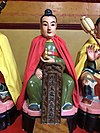|
Tai Sui
Tai Sui is a Chinese name for stars directly opposite the planet Jupiter (木星 Mùxīng) in its roughly 12-year orbital cycle. Personified as deities, they are important features of Chinese astrology, Feng Shui, Taoism, and to a lesser extent Chinese Buddhism.   The 12 signs of the Chinese zodiac were based on divisions of the Jovian orbital cycle, rather than as in the western zodiac—the apparent motion of the sun relative to the celestial sphere. The star thought to oppose Jupiter during each year of the cycle was personified as a heavenly general or cycle god and was believed to help the Jade Emperor control the mortal world. By the Warring States period, the Tai Sui had become gods in the popular astrology; but no written records have been found of their worship prior to the Han dynasty. The earliest such record is found in Wang Chong's first-century Lunheng. There are several legends related to the Tai Sui,[citation needed] usually about people suffering disaster after disrespecting or ignoring them. Their number later quintupled to sixty based on combinations of the twelve divisions (reckoned using the earthly stems) with the five Chinese elements of fire, earth, metal, water, and wood. Each of the gods' features and attributes signifies the well-being of that year. For example, if the Tai Sui of a year holds a pen,[who?] this signifies political unrest for that particular year.[why?] On the other hand, a Tai Sui of the year who holds a spear or sword,[who?] signifies a need to work hard and excel in that year.[why?] Yin Jiao, leader of the sixty Taisui Xingjun gods, doesn't govern any year in the 60-year cycle, and all of them were governed by one of the 60 subordinate Taisui. Yin Jiao in this context is called Taisui Tongling Yin Yuanshuai (Commander of the Tai Sui, General Yin). In Japan and Japanese folklore however, "Taisui Xingjun" is just one singular god.[1][2][3] PracticesIn Taoism, those whose birth signs or other features clash with the Tai Sui of the year face misfortunes or disturbances for that year. This applies in each year to people born under four of the twelve animal zodiac signs. In 2017 for example, it applied to people born in the years of the rat, rabbit, horse and rooster. In Taiwan as the lunar year begins, people go to temples to seek peace and protection and drive away bad influences. This ceremony is known as "An Tai Sui" or pacifying the Tai Sui of the Year. In return, worshipers will receive a protective talisman from the temple which will give the person one year's spiritual protection.[4] This tradition is also practiced by other Overseas Chinese communities. In Chinese culture it has been traditionally considered taboo to build a house facing Taisui (or in the directly opposite direction) in the corresponding year of the Chinese zodiac. A similar belief is associated with moving houses and the line drawn through the old and new dwellings.[5][6]
Images of the Deities of the 60 Heavenly General of Tai Sui in correspondence to the previous detailed table above (refer to the Year number to Tai Sui and Heavenly General, e.g.: Year 1 – 甲子太歲 Jiǎ-Zǐ Tài-Suì 金辨大將軍 Jīn Biàn Dà-Jiāng-Jūn) See alsoReferences
External linksWikimedia Commons has media related to Tai Sui. |
||||||||||||||||||||||||||||||||||||||||||||||||||||||||||||||||||||||||||||||||||||||||||||||||||||||||||||||||||||||||||||||||||||||||||||||||||||||||||||||||||||||||||||||||||||||||||||||||||||||||||||||||||||||||||||||||||||||||||||||||||||||||||||||||||||||||||||||||||||||||||||||||||||||||||||||||||||||||||||||||||||||||||||||||||||||||||||||||||||||||||||||||||||||||||||||||||||||||||||||||||||||||||||||||||||||||||||||||||||||||||||||||||||||||||||||||||||||||||||||||||||||||||||||||||||||||||||||||||||||||||||||||||||||||||||||||||||||||||||||||||||||||||||||||||||||||||||||||||||||||||||||||||||||||||||||||||||||||||||||||||||||||||||||||||||||||||||||||||||||||||||||||||||||||||||||||||||||||||||||||||||||||||||||||||||||||||||||||||||||||||||||||||||||||||||||||||||||||||||||||||||||||||||||||||||||||||||||||
























































































































